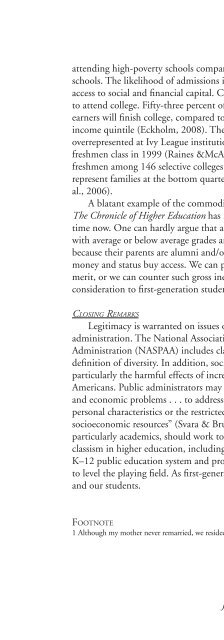WINTER 2012 - National Association of Schools of Public Affairs and ...
WINTER 2012 - National Association of Schools of Public Affairs and ...
WINTER 2012 - National Association of Schools of Public Affairs and ...
You also want an ePaper? Increase the reach of your titles
YUMPU automatically turns print PDFs into web optimized ePapers that Google loves.
Cheryl Simrell King<br />
When they get to college, working-class kids usually go to “get a job,” <strong>and</strong><br />
are thus channeled into fields with clear prospects, like teaching <strong>and</strong> nursing<br />
(for women), engineering (for men), <strong>and</strong> business/management (for women <strong>and</strong><br />
men). The public, liberal arts college where I teach is earning a good reputation<br />
for positive educational experiences for first-generation students. Yet, many <strong>of</strong><br />
our first-generation students have a hard time in a liberal arts college. While<br />
things are changing, working-class kids are <strong>of</strong>ten educated through high school<br />
in places that stress performance <strong>and</strong> rote learning. These students, when they<br />
go to college, do well when rote learning is required but struggle with creative/<br />
analytical thinking assignments. Furthermore, <strong>of</strong>ten the home does not socialize<br />
first-generation <strong>and</strong>/or working-class students to discuss current events, argue<br />
about politics, or use critical <strong>and</strong> analytical reasoning to work through problems<br />
or deal with conflict. When put into a college situation requiring these attributes,<br />
in addition to highly developed verbal <strong>and</strong> written argumentation skills,<br />
working-class <strong>and</strong> first-generation students struggle (Casey, 2005). Meanwhile,<br />
their pr<strong>of</strong>essors mostly do not know why these students are having such a hard time.<br />
These adjustments problems are compounded by class issues around what<br />
G<strong>of</strong>fman (1959) called “presentation <strong>of</strong> self.” How we present ourselves to others is<br />
related to class, race, sex, <strong>and</strong> ethnicity. Here, class is particularly important because<br />
self-presentation is a significant variable in working environments. There are<br />
particular self-presentation expectations for middle- <strong>and</strong> upper-class environments<br />
having to do with everything from dress to speech to how we hold our bodies,<br />
not to mention etiquette <strong>and</strong> other finer points <strong>of</strong> living. Working-class students<br />
usually do not have the right presentation <strong>of</strong> self skills for higher class situations;<br />
moreover, they <strong>of</strong>ten hold onto their working-class presentations as a form <strong>of</strong> self<br />
defense <strong>and</strong>, in some cases, a form <strong>of</strong> class resistance. For example, in his study<br />
<strong>of</strong> “working-class lads” in Birmingham, Engl<strong>and</strong>, Paul Willis observed that acts<br />
<strong>of</strong> resistance to middle-class norms—the defiance with which the young men<br />
expressed their anger at class inequalities—helped reinforce the class structure by<br />
further entrenching them in their working-class status (Willis, 1982, in Rubin,<br />
1994). In short, working-class students <strong>of</strong>ten have much going against them in<br />
their desire to succeed in academic life <strong>and</strong> very little working in their favor.<br />
ANOTHER STORY<br />
When I introduce myself to students at the beginning <strong>of</strong> a term, the first<br />
thing I say is, “I am a first-generation college graduate.” That is all I have to say.<br />
That statement, alone, gives most first-generation students the permission they<br />
need to approach me. And interestingly, class—not sex/gender—ends up being<br />
the significant element that leads to most <strong>of</strong> my mentoring relationships.<br />
As I gaze at a group <strong>of</strong> students in a classroom, I can usually spot those who<br />
are first generation by their class markers <strong>and</strong>/or presentation <strong>of</strong> self. Often, those<br />
students represent the two ends <strong>of</strong> the spectrum: They are either trying too hard<br />
to fit in <strong>and</strong> “wearing” ill-fitting middle-/upper-class markers, or they are in a<br />
58 Journal <strong>of</strong> <strong>Public</strong> <strong>Affairs</strong> Education

















